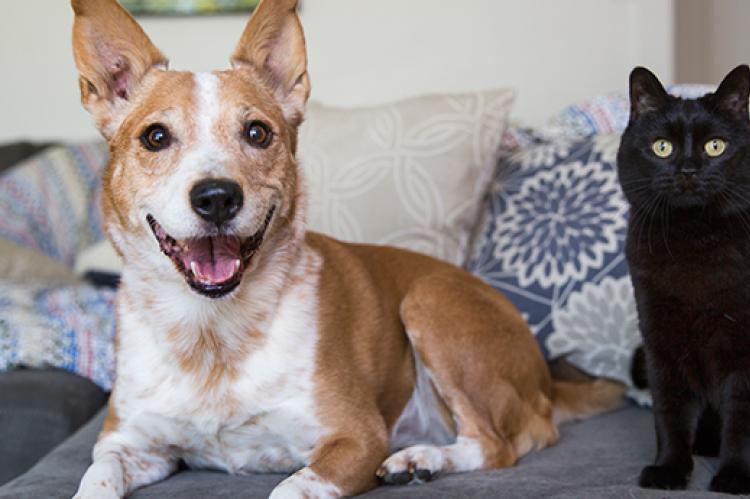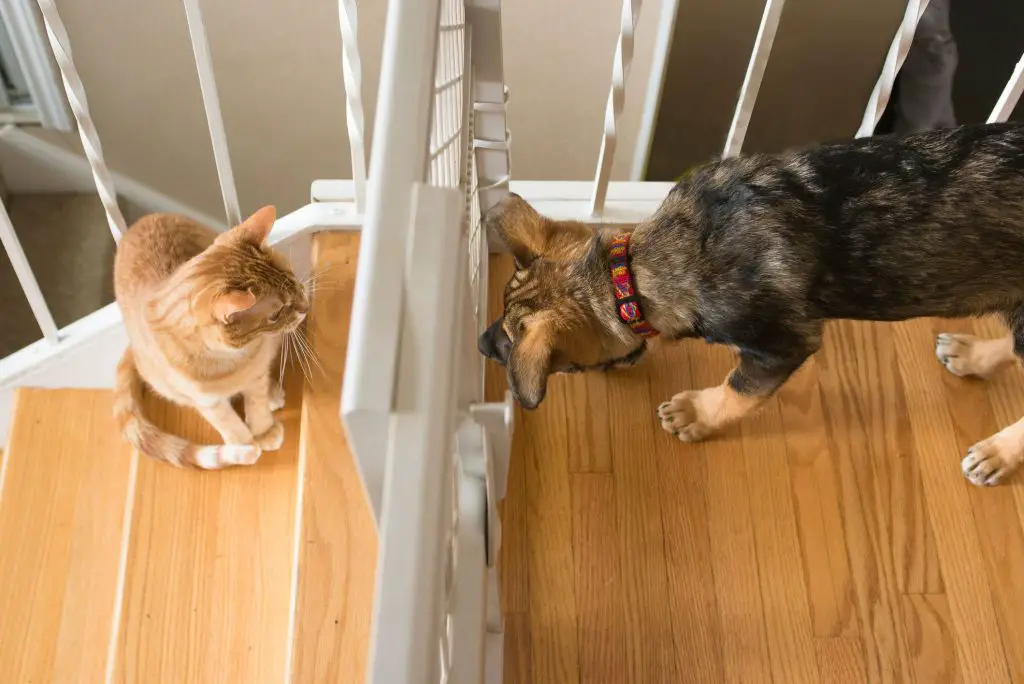A cat hisses at a dog to express fear, aggression, or territoriality towards the dog. When a cat feels threatened by a dog, it may resort to hissing as a warning sign.
This behavior is often seen in situations where the cat feels its territory is being invaded by the dog or when the cat feels intimidated. Hissing is a way for the cat to communicate its discomfort and establish boundaries. It may also be a defensive tactic to deter any potential harm from the dog.
Understanding the reasons behind the cat’s hissing can help pet owners address the issue and ensure a peaceful coexistence between their cat and dog.
Understanding Cat Behavior
Cats hiss at dogs because they feel threatened or territorial. Understanding cat behavior can help you prevent conflicts between your pets and create a harmonious environment at home.
Why Do Cats Hiss?
Cat hissing is a common behavior exhibited by felines, and it is important for pet owners to understand why their cat is behaving this way. Hissing is a natural defense mechanism for cats, and it serves as a warning signal to potential threats or when they feel scared, threatened, or uncomfortable.
Typical Scenarios Of Cat Hissing
Cats may hiss when they encounter unfamiliar animals, such as dogs. This can be a way for them to establish boundaries and assert their dominance or protect themselves from potential harm. It is important to note that not all cats will hiss at dogs, as individual personality and previous experiences play a significant role in determining their reactions.
Importance Of Analyzing Cat Behavior
Analyzing cat behavior, including hissing, is crucial for pet owners to ensure their feline’s wellbeing and create a safe and comfortable environment. By understanding the underlying causes of their hissing, pet owners can address any potential issues, provide appropriate socialization, and take necessary steps to prevent stressful situations. Seeking professional advice from a veterinarian or animal behaviorist can be beneficial if the hissing persists despite attempts to alleviate the stress or discomfort.

Credit: resources.bestfriends.org
Establishing Boundaries With Dogs
Introducing a new dog to a cat can be a delicate process, especially when it comes to establishing boundaries and minimizing territorial conflicts. Cats and dogs have their own instincts, and it’s essential to understand and address these differences to promote a harmonious environment at home.
When a cat hisses at a dog, it’s often a sign of discomfort or fear. As such, it’s essential to closely monitor their interactions and be aware of the subtle cues that indicate your cat’s unease. These signs may include flattened ears, a puffed-up tail, dilated pupils, or an arched back.
To ease tension, provide each pet with their separate space, such as designated areas for eating, sleeping, and using the litter box. It’s also crucial to gradually introduce the pets to each other’s scent through scent swapping. This can be done by rubbing a towel on one pet and letting the other sniff it.
Additionally, when allowing face-to-face interactions, always supervise and reward positive behavior, such as calm and non-aggressive interactions. By respecting your cat’s boundaries and creating a safe environment, you can help them build a positive relationship with the dog over time.
Identifying Triggers For Cat Hissing
BLOG POST TITLE: Why is My Cat Hissing at Dog?
Recognizing Body Language Cues
Cats use their body language to communicate their feelings, and being able to understand these cues can help you identify triggers for cat hissing. When a cat is feeling threatened or fearful, they may puff up their fur, flatten their ears against their head, arch their back, or show their teeth. Additionally, their tail may be held low or tucked between their legs. Paying attention to these signs can help you address the issue of your cat hissing at your dog more effectively.
1. Introduction: Introducing a new dog into the household can trigger cat hissing as cats are territorial animals. It takes time for them to adjust to the presence of a new pet.
2. Resource guarding: Cats may hiss if they feel their resources such as food, water, or litter box are being invaded or threatened by the dog.
3. Fear and insecurity: If a cat feels threatened, intimidated, or cornered by the dog, they may respond with hissing as a defensive mechanism.
It is essential to react appropriately to specific situations to minimize cat hissing behavior. Ensure that both your cat and dog have their own safe spaces within the house where they can retreat when they need to. Gradual introductions, positive reinforcement, and providing plenty of environmental enrichment can also help reduce tension and ensure a harmonious coexistence between your cat and dog.
Handling Cat Aggression Towards Dogs
Creating safe spaces for cats: It is important to provide your cat with its own designated safe space where it can retreat to when it feels threatened or overwhelmed. This can be a separate room with its bed, toys, scratching posts, and litter box. By creating a safe space, you can help your cat feel more secure and reduce the likelihood of aggression towards dogs.
Seeking professional help when needed: If your cat’s aggression towards dogs is severe or if your attempts to prevent it have been unsuccessful, it may be beneficial to seek the assistance of a professional animal behaviorist or a veterinarian who specializes in behavior. They can evaluate the situation, provide you with expert advice, and develop a customized behavior modification plan to address the underlying causes of the aggression and improve the relationship between your cat and dog.
Promoting Positive Interactions
In order to understand why your cat is hissing at your dog, it’s important to focus on promoting positive interactions and building trust between these two animals. Encouraging socialization in controlled environments can be an effective way to help them get along. This can include supervised playtime, where they have the opportunity to interact with each other under close observation. Training techniques can also play a crucial role in establishing a harmonious relationship. For example, using positive reinforcement to reward both the cat and the dog for calm and friendly behavior can help them associate each other’s presence with positive experiences. Consistency and patience are key when implementing these techniques. Remember, it’s essential to respect their individual boundaries and allow them to establish their own comfort levels with one another. With time and proper guidance, your cat and dog can develop a positive and peaceful coexistence.
Stress And Anxiety In Cats
Understanding the impact of stress on cats is crucial in addressing behavioral issues such as hissing at dogs. Cats are sensitive animals, and stressful situations can trigger a defensive response.
Identifying Stress-related Behaviors In Cats
It’s important to observe your cat’s behavior to determine if stress is the underlying cause of their hissing at dogs. Common stress-related behaviors include hiding, excessive grooming, aggression, and a change in appetite or litter box usage.
Implementing Stress-reduction Techniques
To help alleviate stress in your cat, create a calm and safe environment by providing hiding places, vertical spaces, and scratching posts. Establish a regular routine and ensure they have access to resources like food, water, and litter boxes. Play with them using interactive toys to stimulate their minds and provide healthy outlets for energy. Consider using pheromone diffusers or calming supplements under the guidance of a vet.
By understanding stress and anxiety in cats and implementing stress-reduction techniques, you can help your cat feel safe and reduce their hissing at dogs.
Encouraging Mutual Respect And Friendship
Having a cat and a dog in the same household can sometimes lead to conflicts and hissing. However, with positive interactive play sessions, you can help your cat and dog build a strong bond and develop respect for each other. These play sessions provide an opportunity for them to engage in supervised and controlled interactions, gradually getting accustomed to each other’s presence.
Rewards and positive reinforcement play a crucial role in encouraging desired behaviors. When your cat and dog interact positively, reward them with treats and praise, reinforcing their good behavior. This helps create a positive association between each other’s presence and positive experiences, reducing the likelihood of hissing or conflict.
Fostering a bond between your cat and dog involves gradual introductions and supervised interactions. Start by allowing them to sniff each other’s belongings, then progress to controlled face-to-face meetings in a neutral territory. Gradually increase their exposure to each other while ensuring they feel safe and comfortable.
By following these tips and giving them time to adjust, you can encourage mutual respect and friendship between your cat and dog, minimizing hissing and fostering a harmonious household.
Conclusion
To sum up, understanding why your cat is hissing at your dog is crucial in fostering a harmonious environment for your pets. By considering factors such as territorial instincts, previous experiences, and proper introductions, you can work towards resolving any tension between them.
Remember, patience and positive reinforcement are key when helping your cat and dog build a peaceful relationship. With time and effort, they can learn to coexist happily under one roof.


